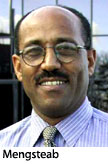By Paula Schlueter Ross
Mission executives from 29 of The Lutheran Church–Missouri Synod’s 35 districts already have taken the orientation training for the Ablaze! “Covenant Congregations” church-planting initiative — an “overwhelming” response, s ays Rev. Yohannes Mengsteab, national director for new mission fields development with LCMS World Mission.
ays Rev. Yohannes Mengsteab, national director for new mission fields development with LCMS World Mission.
In fact, what impressed Mengsteab most at a recent two-day training event, held May 9-10 in St. Louis, were the questions the district representatives posed: “How can we do it?” and “What do we need to do?,” not “Why should we do it?”
“That’s really very encouraging,” he said, and shows “the districts are ready” to help their congregations plant 2,000 more congregations nationwide by 2017 as part of the Synod’s Ablaze! Gospel-sharing movement.
Mengsteab is spearheading the effort that is asking districts to identify 600 “healthy, growing congregations” — about 10 percent of the 6,100 congregations that make up the LCMS — and provide them with training, resources, and encouragement that would enable each of them to “plant” up to four “daughter” congregations over the next 10 years.
Those that say “yes” to the invitation to become an Ablaze! Covenant Congregation would pledge to:
- serve their community as a “mission outpost” by making outreach their top priority;
- devote their “resources and talents” to equip their members to witness to their family, friends, coworkers, neighbors, and “the strangers God brings into their lives”; and
- send and support their members for the purpose of planting congregations “as the Holy Spirit enables, directs, and guides them.”
Although the congregations will take the lead in church planting, they won’t be on their own, says Mengsteab. LCMS World Mission plans to provide funding, assessments, and training to Covenant Congregations. Also providing assistance will be Lutheran Church Extension Fund, Church Development Partners, the Center for U.S. Missions, and the two LCMS seminaries.
In fact, the seminaries — Concordia Seminary, St. Louis, and Concordia Theological Seminary, Fort Wayne — hold the largest piece of the support puzzle, according to Mengsteab, because of their commitment to “develop distance education in support of our church-planting movement.”
A resolution that would create a new seminary track for “specific ministry pastors” — whose primary task would be church planting — is expected to be considered by the Synod’s national convention this month in Houston. The resolution has been endorsed by both seminaries, the Synod’s Board for Pastoral Education, and the LCMS Council of Presidents.
Mengsteab is hoping delegates adopt the resolution — just as they approved in 2004 the North American Ablaze! goal of planting 2,000 congregations by 2017 — “because training the planters is a key component of the strategy.” Setting goals is futile if there are not enough hands to do the work, he says, and that’s precisely the reason the Synod’s outreach goals in years past were not met — they failed to raise up the necessary leaders.
This time around, Synod districts and congregations are being encouraged to use the same two-pronged strategy LCMS World Mission has used for decades on overseas mission fields: church planting and leadership development. Plant a congregation and train local leaders.
Identifying those new leaders is among the first steps of the Ablaze! Covenant Congregations effort, along with devising new theological-education options to train them. Districts that have taken part in the program’s orientation are being asked to pass that information on to their congregations in an effort to identify those who are willing to plant “daughter” congregations.
Earlier this month, the Texas District brought together 91 people from 37 congregations for what it called an “M2C Retreat.” “M2C” refers to the district’s Ablaze! — or mission — goal of planting 200 congregations by 2017.
Paul Krentz, one of the district’s three mission and ministry facilitators, said the training event was led by six of the district’s church-planting teams, who shared their strategies for starting congregations.
“The three major pieces [of church planting] are the right person, the right place, the right plan. And we’ve been saying ‘the right person, the right person, the right person, the right place, the right plan,’” said Krentz. “Having listened to all these mission planters — I think any one of them could have planted a church anywhere because they have the instinct, the passion, and the ability to … understand what’s going to work in a particular community.”
Those who attended the retreat are “very fired up” about the mission-planting goal, Krentz said, even though church planting is nothing new for the district.
“We’ve been planting on average 10 missions a year for quite some time, and we’re just saying we’ve got to ramp that up,” Krentz said. “We’re not where we need to be with the way population is growing in this state.”
Planting 200 congregations over 10 years might pose a challenge, but it’s “absolutely possible” for Texas congregations to meet that goal, he said. “It’s going to be the Holy Spirit working through those churches. But I’m very optimistic.”
Mengsteab concurs that people are the most precious resource for mission. “Church planting, in principle, doesn’t take money,” he said. “It just takes committed people who want to proclaim the Gospel to those people who do not know Jesus yet.”
He encourages growing congregations, regardless of size, to “multiply themselves.” (Click here to read sidebar, “Closeup of a ‘Covenant Congregation.'”)
Likewise, he asks districts to “spend a lot of time with the healthy congregations, encouraging them and supporting them to plant, to multiply themselves, and provide the resources so that the mission of the church is not hindered by a lack of leadership.”
Mengsteab said he expects all 35 LCMS districts to be “involved, in one way or another, in church planting” by this time next year. Districts that are largely rural, with dwindling populations, may have to consider “new ways of doing church planting and congregational ministry in the rural communities,” such as house churches and part-time pastors, he said.
But Mengsteab believes one thing is certain: If the Synod is serious about launching a church-planting movement in t




